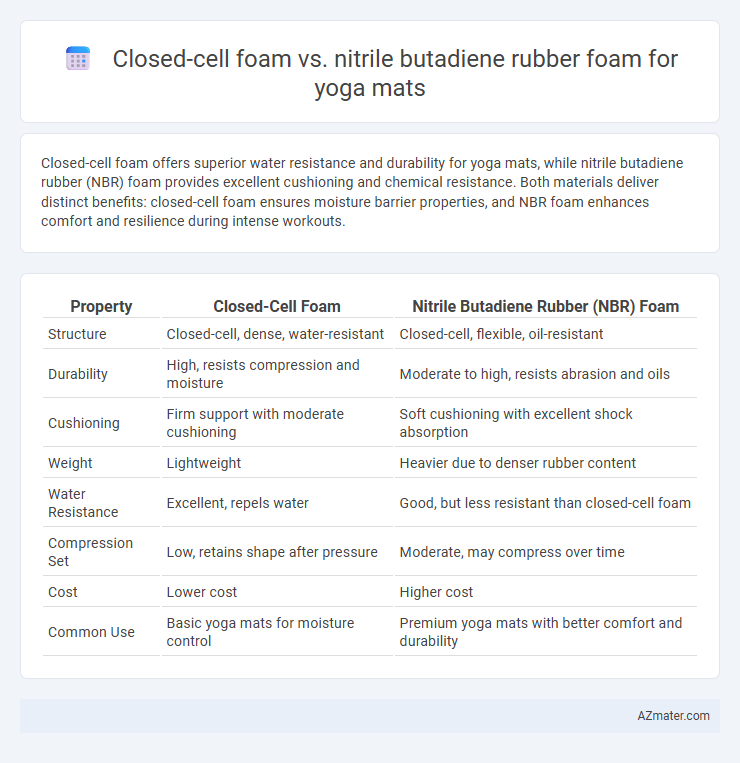Closed-cell foam offers superior water resistance and durability for yoga mats, while nitrile butadiene rubber (NBR) foam provides excellent cushioning and chemical resistance. Both materials deliver distinct benefits: closed-cell foam ensures moisture barrier properties, and NBR foam enhances comfort and resilience during intense workouts.
Table of Comparison
| Property | Closed-Cell Foam | Nitrile Butadiene Rubber (NBR) Foam |
|---|---|---|
| Structure | Closed-cell, dense, water-resistant | Closed-cell, flexible, oil-resistant |
| Durability | High, resists compression and moisture | Moderate to high, resists abrasion and oils |
| Cushioning | Firm support with moderate cushioning | Soft cushioning with excellent shock absorption |
| Weight | Lightweight | Heavier due to denser rubber content |
| Water Resistance | Excellent, repels water | Good, but less resistant than closed-cell foam |
| Compression Set | Low, retains shape after pressure | Moderate, may compress over time |
| Cost | Lower cost | Higher cost |
| Common Use | Basic yoga mats for moisture control | Premium yoga mats with better comfort and durability |
Introduction to Yoga Mat Materials
Closed-cell foam offers excellent water resistance, cushioning, and durability, making it a preferred material for yoga mats that require support and moisture protection. Nitrile butadiene rubber (NBR) foam is renowned for its superior shock absorption, non-toxic composition, and thermal insulation, providing comfort and safety during yoga practice. Both materials cater to different user preferences, with closed-cell foam ideal for dense, firm surfaces and NBR foam favored for its softness and grip.
What is Closed-Cell Foam?
Closed-cell foam is a type of foam characterized by its dense structure where individual cells are completely enclosed and not interconnected, providing superior water resistance and durability compared to open-cell foams. This material offers excellent cushioning, impact absorption, and insulation, making it ideal for yoga mats that require firm support and moisture resistance. Compared to nitrile butadiene rubber (NBR) foam, closed-cell foam is often lighter, more resilient to compression, and less prone to absorbing sweat and odor, enhancing hygiene and longevity in yoga practice.
Overview of Nitrile Butadiene Rubber (NBR) Foam
Nitrile Butadiene Rubber (NBR) foam is a synthetic rubber material known for its excellent cushioning, durability, and resistance to oil, chemicals, and heat, making it ideal for yoga mats. Compared to closed-cell foam, NBR foam offers superior density and resilience, providing enhanced support and comfort during workouts. Its closed-cell structure also ensures moisture resistance and easy maintenance, contributing to hygienic and long-lasting yoga mats.
Comfort and Cushioning Comparison
Closed-cell foam provides superior cushioning and moisture resistance, making it ideal for yoga mats designed for high-impact poses and sweat absorption. Nitrile butadiene rubber (NBR) foam offers excellent comfort with its soft, dense texture and better durability under prolonged use, ensuring consistent support during workouts. While both materials excel in comfort, closed-cell foam is preferred for its lightweight, water-resistant properties, whereas NBR foam enhances cushioning with its resilient, shock-absorbing performance.
Durability and Longevity
Closed-cell foam offers superior durability for yoga mats due to its dense, non-porous structure that resists moisture, compression, and wear over time. Nitrile butadiene rubber (NBR) foam provides excellent longevity with high resilience and resistance to oils, chemicals, and abrasion, making it ideal for mats exposed to heavy use. Both materials ensure extended lifespan, but NBR foam typically outperforms in maintaining cushioning properties under prolonged stress.
Water and Sweat Resistance
Closed-cell foam yoga mats offer superior water and sweat resistance due to their dense structure that prevents moisture absorption, making them ideal for intense or hot yoga sessions. Nitrile butadiene rubber (NBR) foam provides excellent resistance to water and sweat as well, but its slightly porous surface may trap moisture over time, requiring regular cleaning to maintain hygiene. For optimal performance in moisture-heavy environments, closed-cell foam mats deliver enhanced durability and quick drying compared to NBR foam mats.
Eco-Friendliness and Sustainability
Closed-cell foam yoga mats typically provide better resistance to moisture and durability but are often made from non-biodegradable synthetic materials, impacting eco-friendliness negatively. Nitrile butadiene rubber (NBR) foam mats, while offering cushioning and resilience, are derived from petroleum-based sources and have limited recyclability, posing challenges for sustainability. For environmentally conscious consumers, natural rubber or TPE options may offer improved biodegradability and lower ecological footprint compared to both closed-cell and NBR foams.
Grip and Slip Resistance
Closed-cell foam offers superior grip and slip resistance for yoga mats due to its dense, non-porous structure that prevents moisture absorption and maintains a stable surface during intense sessions. Nitrile butadiene rubber (NBR) foam, while durable and cushioned, tends to absorb sweat more readily, potentially reducing slip resistance over time. The enhanced traction of closed-cell foam makes it a preferred choice for yogis seeking secure footing and stability in diverse practice environments.
Maintenance and Cleaning Ease
Closed-cell foam yoga mats resist moisture and sweat penetration, making them easier to clean with simple wiping or mild soap solutions, and they do not harbor bacteria or odors. Nitrile butadiene rubber (NBR) foam mats absorb less moisture but may require more frequent deep cleaning due to surface texture that traps dirt and oils. Closed-cell foam maintains durability with minimal maintenance, while NBR foam benefits from regular cleaning to prevent deterioration and maintain hygiene.
Price and Value Analysis
Closed-cell foam yoga mats typically offer a lower price point due to their simpler manufacturing process and widespread availability, making them an affordable option for beginners. Nitrile butadiene rubber (NBR) foam mats, while priced higher, provide superior durability, cushioning, and resistance to sweat, increasing long-term value for frequent practitioners. The initial cost difference is offset by NBR's enhanced lifespan and comfort, delivering better overall value despite the premium price.

Infographic: Closed-cell foam vs Nitrile butadiene rubber foam for Yoga mat
 azmater.com
azmater.com